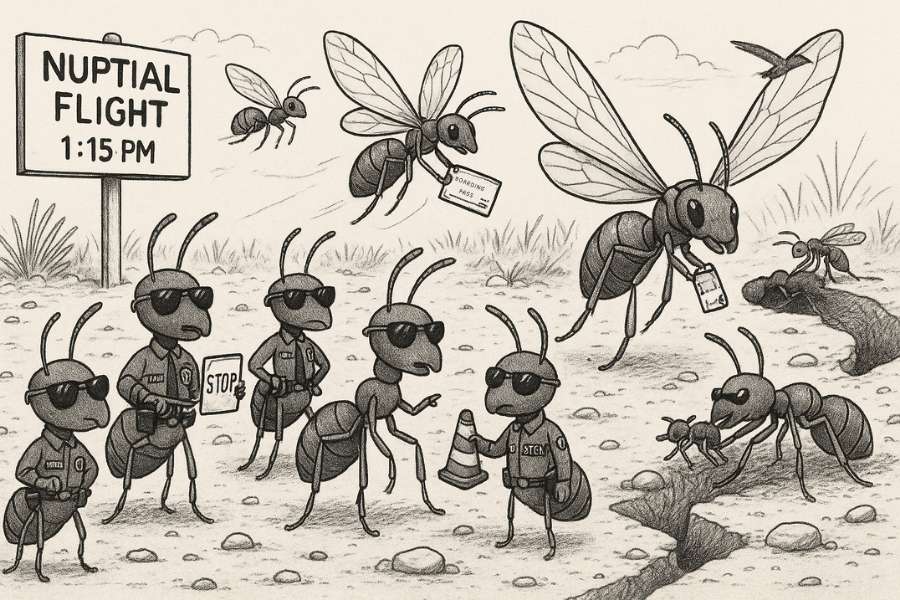Suddenly swarmed by big ants with wings? Don’t reach for the bug spray – this is nature throwing a surprise wedding right in your backyard.
A surprising sight in the garden
It started out like any other lunch in the garden. I was halfway through my sandwich when something flickered in the corner of my eye – just a quick movement above the grass. I glanced up but didn’t think much of it. Then it happened again. Something was flying up from the ground and vanishing into the air.
Curious, I got up and walked over. That’s when I saw them.
Large ants with wings – dozens of them – climbing around on the blades of grass and taking off every now and then. Around them, smaller ants were scurrying in every direction, some even tugging on the wings of their larger kin. It was happening in between the paving stones, too, but there, the smaller ants looked different from the others.
I should mention: we have a green woodpecker family that visits our yard regularly. A mother and two juveniles, hopping between the sidewalk cracks and grass border, snacking on ants like it’s their personal buffet. I’d seen them pecking at these same spots just days before. And now I was seeing the other side of the story – an entire generation of ants taking flight, right under our noses.
What are alate ants and are they pests?
If you’ve ever seen a sudden burst of large ants with wings pouring out of the ground, it’s easy to assume the worst. Are they termites? Is it an infestation? Do I need to call pest control?
The short answer: no. What you’re seeing is one of the most fascinating – and brief – stages in an ant’s life cycle.
These winged ants are called alates. They’re the reproductive members of the colony: virgin queens and males bred specifically for this moment. Most of the ants we see in daily life are sterile workers, but once a colony reaches maturity, it produces these winged castes to carry its genetic legacy forward.
Alates aren’t invaders. They’ve been developing quietly underground for months, sometimes years. And when the conditions are just right – after rain, during warm humid weather – they emerge in coordinated swarms to mate and disperse.
They’re not dangerous. They don’t bite or sting (at least not most species), and they aren’t trying to take over your home. In fact, most of them won’t survive more than a day or two. Only the mated queens will have a shot at founding a new colony – and even then, the odds are low.
Why do alate ants swarm all at once?
It can feel a little eerie watching these insects pour out of the ground by the dozens, sometimes hundreds, in what looks like a coordinated invasion. But it’s not random, and it’s definitely not an attack.
These alate ants are emerging for a very specific reason: to take part in a synchronized mating event known as the nuptial flight. What looks chaotic on the surface is actually one of the most tightly timed phenomena in the insect world.
The trigger? Weather. Most alate ants fly out of the nest on warm, humid days – typically one to two days after a rainfall, when the ground is soft and the air is still. These conditions are perfect for flight, and they help ensure that newly mated queens can dig a suitable nest without hitting dry or compacted soil.
What’s remarkable is that this happens not just within a single colony, or garden, but across entire neighborhoods. Multiple ant colonies – sometimes even different species – coordinate their flights to occur on the same day. This maximizes the odds of cross-colony mating and boosts genetic diversity.
If it seems like all the ants in your yard chose the same afternoon to take to the skies, they probably did. That sudden, synchronized swarm is by design – nature’s version of a carefully timed launch window.
Inside the alate ant nuptial event: flight, mating, and aftermath
Each alate has one job. Males fly out first, forming loose clouds of movement above the ground. Female alates – potential queens – join the airspace soon after. In some species, males form aggregations and compete for queens. In others, the females emit pheromones to draw males in.
It may last only a few minutes or stretch across an afternoon, but the goal is the same: mate with individuals from outside your own colony, then disperse. Males spend all their stored energy chasing and mating; once they’ve done their part, they die – sometimes within hours.
What happens after the ant mating flight?
After mating, most queens shed their wings and begin the next chapter of their lives: founding a new colony. In my own yard, I saw several of these now-wingless ants crawling across a newly sown area of grass, seemingly on a mission. They weren’t returning to the original nest – they were searching for somewhere new.
Unfortunately, I didn’t see it myself, but I read that many of the queens will actually eat their own wings once they’ve shed them. It sounds strange at first, but it makes sense – those wings are packed with protein, and when you’re about to spend weeks underground without food, you make use of whatever you’ve got. It’s a kind of brutal efficiency that seems to define ant life.
And then there was something else I noticed in the yard. In one patch, the smaller worker ants were dragging some of the winged ones – those that hadn’t flown – back underground. At first, I thought maybe they were helping them. But from what I’ve read, it’s more likely the colony was reclaiming those failed alates for nutrients. Not exactly a rescue, but again – nothing is wasted.
It’s easy to think the nuptial flight is the grand finale. But for the queens that survive, it’s just the beginning.
Understanding the alate ant lifecycle from winged form to colony
Once a mated queen has shed her wings, she begins the risky process of founding a new colony – alone. She has no workers, no support, and no backup. Everything depends on her ability to survive long enough to raise her first brood.
To do that, she must find a suitable nest site. Some queens dig small chambers directly into soft soil. Others may take advantage of existing cracks or hollows – beneath rocks, inside decaying wood, or even between sidewalk stones. In my own yard, I watched wingless queens roaming the ground, searching, pausing, then moving on, as if evaluating potential real estate.
What’s astonishing is that during this early phase, the queen doesn’t eat. Instead, she lives entirely off her own internal resources. The fat stored in her body, along with the wing muscles she no longer needs, are gradually broken down to fuel her metabolism and nourish her first larvae.
That first generation of ants – called nanitics – is typically smaller than future workers. Their job is to care for the queen and help expand the nest. Once they’re in place, the queen rarely – if ever – leaves the colony again.
But most queens don’t make it that far. Whether eaten by predators, caught out by weather, or simply unable to raise their first brood, the odds are overwhelmingly against them. Out of the thousands of alates that take flight during a nuptial event, only a tiny fraction will ever establish a lasting colony.
And yet, it works. That high-risk, high-reward strategy is part of what has made ants one of the most successful life forms on Earth.
Why the alate ant lifecycle matters for your garden and beyond
It’s easy to see the alate ant lifecycle as a curiosity – something that happens, briefly, and then disappears. But it’s also a vital part of the ecosystem, with ripple effects far beyond one patch of lawn.
When alates take flight and disperse, they carry the genetic future of their colonies. This mass movement helps prevent inbreeding and spreads healthy ant populations across the landscape. It’s how genetic diversity is maintained – and how ecosystems stay resilient.
From a gardener’s perspective, ants aren’t just busybody insects – they’re ecosystem engineers. Their tunnels help aerate soil. Their presence attracts birds like woodpeckers and other natural pest controllers. And their scavenging keeps decomposing material in check. In short, they do far more good than harm.
The nuptial flight is also a moment of connection. It reminds us that even the most ordinary-seeming creatures live complex, seasonal lives shaped by weather, competition, and ancient evolutionary strategies. When we stop and watch – even for a few minutes – we get to witness something that connects our gardens to millions of years of natural history.
How to spot an ant nuptial flight in your yard
If you’ve never seen an ant nuptial flight before, it’s the kind of thing you could walk right past – until suddenly, it’s happening all around you.
They don’t last long. A few hours on the right afternoon, and that’s it. But once you’ve seen it, you’ll start noticing the signs. And after that, you might even be able to guess when the next one’s coming.
Here are some early clues to watch for:
- Recent rain: One to two days after a good soaking is prime time.
- Warm, humid weather: Temperatures over 22°C (72°F) with minimal wind.
- Still air: Flights rarely happen on breezy or stormy days.
- Sudden surface activity: If you see small ants emerging en masse or holes opening in the soil, something’s about to happen.
Most flights happen in late morning to mid-afternoon, but some species take off in the early evening. If you notice birds flocking to one spot or ants suddenly becoming hyperactive near their nest, chances are you’re minutes away from a launch.
If you’re lucky, you’ll see the exact moment the first alates lift off – wings shimmering in the light, spiraling upward into the trees or disappearing into the open sky.
I didn’t set out to study ants this summer. I just happened to be in the right place at the right time – with a sandwich in one hand and a front-row seat to a centuries-old biological performance. Watching those winged queens take off (and stumble, and get dragged underground, and crawl away wingless but determined) reminded me how much goes on right under our feet.
It’s fast, subtle, and gone before you know it. But if you catch it once, you’ll never forget it.

Julie is a biologist turned science writer living in Germany. She shares her passion for traditional German water bath canning, seasonal cooking, and gardening on Old World Preserves.

